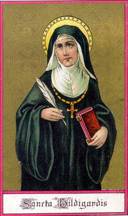Hildegard of Bingen
1098-1179
 Hildegard of Bingen was a 12th century Christian mystic, a nun and head of a Benedictine convent in Germany. She wrote and preached on a wide variety of topics, including theological, botanical, and medicinal texts. She also composed liturgical songs, poems, and the first surviving morality play.
Hildegard of Bingen was a 12th century Christian mystic, a nun and head of a Benedictine convent in Germany. She wrote and preached on a wide variety of topics, including theological, botanical, and medicinal texts. She also composed liturgical songs, poems, and the first surviving morality play.
Hildegard's book The subtleties of the diverse nature of created things (circa 1151-1158) contains several parts: Natural history, the Book of simple medicine, and Causes and cures. Natural history has a section on plants, as well as other natural phenomena (animals, minerals, and metals) and their medicinal uses. She frames these uses in terms of the ancient theory of humors, classifying them as hot, dry, wet, or cold.
Hildegard learned the ancient doctrine of humors in her training to be a Benedectine nun; she also had a broad knowledge of folk cures which she gathered on her own. Finally, she created many of her own folk cures including herbal remedies. For example, she suggested a particular plant, which she classified as hot, for the cure of leprosy. She recommended squeezing the juice from the plant and smearing it on the wounds or cooking its flowers to make an ointment to apply to the sores produced by leprosy.
Hildegard was unique for her time, since women were not allowed then to play a role in church affairs. She assumed authority because she had holy visions and heard God speaking to her. She wrote about her visions and drew pictures of them. Her most notable work was Scivas, a book that depicted 26 of her visions.
In the 1150s Hildegard toured Europe, preaching the importance of pacifism, faith, and medicine. Her surviving letters are to secular rulers, popes, as well as ordinary people. In them she makes prophesies, gives advice and, on occasion offers criticism. The quality of her rhetoric has been debated. Her prose was often musical, and did not follow the classical style of ancient orators (Ward, 1999, p. 128, fn 4). Newman (1985) describes Hildegard's prose as having a "painful ignorance of grammar, rhetoric and dialectic."
Writings of Hildegard of Bingen
Know the ways of the Lord
Book of life's merits
Book of the divine works
Book of simple medicine
Book of healing herbs
Causes and cures, also known as Book of compound medicine
Symphony of the harmony of celestial revelations
The play of the virtues
The life of St. Rupert
The life of St. Disibod
Some 300 letters
Full references of the writings of Hildegard of Bingen, arranged chronologically.
Hildegard of Bingen (1988). Symphonia. Ed, Trans. Barbara Newman. Ithaca: Cornell University Press.
Hildegard of Bingen. (1990) Explanation of the rule of St. Benedict. Trans. Hugh Feiss, O.S.B. Toronto: Peregrina Publishing, 1990.
Hildegard of Bingen (1990). Scivias. Trans. Mother Columbia Hart and Jane Bishop, Introduction, Barbara J. Newman, Preface, Caroline Walker Bynum. New York: Paulist Press.
Hildegard of Bingen (1999). On Natural Philosophy and Medicine. Ed. Margaret Berger. Cambridge: Brewer.
Writings about Hildegard of Bingen, arranged alphabetically.
Bartlett, Ann (1992). Miraculous literacy and textual communities in Hildegard of Bingen's Scivias. Mystics Quarterly, 18, 2, 45.
Burnett, C. & Dronke, P. (Eds.) (1998). Hildegard of Bingen: the Context of Her Thought and Art. Warburg Institute Colloquia 4, London.
Davidson, Audrey (ed.) (1992) The Ordo Virtutum of Hildegard of Bingen: Critical Studies. Kalamazoo: Western Michigan University. Early Drama, Art, and Music Monograph Series 18.
Dietrich, Julia (1997). The visionary rhetoric of Hildegard of Bingen. In M. M. Wertheimer (Ed.), Listening to their voices: The rhetorical activities of historical women (pp. 199-214). Columbia, SC: University of South Carolina Press.
Flanagan, Sabina (1998) Hildegard of Bingen: A Visionary Life, 2nd ed. New York: Routledge.
McInerney, Maud Burnett (Ed.) (1998). Hildegard of Bingen (1998). Hildegard of Bingen: A Book of Essays. New York: Garland.
Newman, Barbara (1985). Hildegard of Bingen: Visions and validation. Church History, 1985, 170.
Schipperges, Heinrich (1999) The world of Hildegard of Bingen: Her life, times, and visions, trans. John Cumming. Collegeville, MN: The Liturgical Press.
Ward, J. (1999). Women and Latin rhetoric from Hrosvit to Hildegard. In C. M. Sutherland & R. Sutcliffe (Eds.) The changing tradition: Women in the history of rhetoric (pp. 121-132). Calgary: University of Calgary Press.
